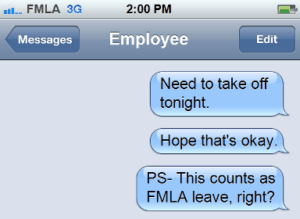The Family and Medical Leave Act (FMLA) is a complex law. While HR pros may never know all the nuances of the law, here are 11 tricks you should know to avoid FMLA headaches.

- Know how many employees you have every day of the year. If you have 50 or more during 20 or more weeks in the current or prior year, you are subject to FMLA. Also, all commonly controlled corporations within a 75 mile radius are combined when making this determination.
- It’s critical you have clear and comprehensive job description for each position in your company. For example, must the employee sit or stand for extended time; use their hands extensively; get in and out of a chair many times during the day; have manual dexterity, turn knobs, squat; lift heavy objects . . . Be specific. Also, separate out major and minor job functions.
- State the days and hours of work needed in the employment application.
- Have employees sign a job description on first day of work.
- To be eligible for FMLA leave, an employee must have worked at least 12 months and 1250 hours in those 12 months (excluding vacation, sick, holiday days), measured back from the first day of FMLA leave. This will always be a moving number, so track accurately.
- Maximum leave is 12 weeks in a 12-month period. But, there are four different ways to measure the 12-month period. No matter which method you use, apply it to all employees.
- In your Employee Handbook (you have one, right?) make sure your FMLA policy is stated separately from your regular vacation, PTO, sick leave, and paid leave policy, so it’s clear what days are used first. In some cases, FMLA leave can run concurrently with sick and vacation leave, worker’s comp, and disability leave.
- Know your state law regarding FMLA leave, because it could give your employees more benefits than federal FMLA law.
- The most frequent reason for an FMLA leave is “serious medical condition”. This has a very complex definition. Make sure you understand it.
- Discussions with employee’s doctor can only address the job description, and whether the employee can perform the essential functions of the job (to be put on leave or brought back from leave). However, you can request the doctor to provide you with certification of a “serious health condition”, thus allowing FMLA leave.
- Before a person comes back from FMLA leave, make sure they get a release from their doctor that the employees can perform their essential job functions.

Why this matters: In 2015 there were more than 1,500 FMLA lawsuits, which was triple, yes I said “triple”, the number from 2012. This issue will become even more contentious in the years ahead for two main reasons:
- The economy is better therefore there are more people employed. More employees simply means FMLA issues are more likely to arise. It’s just statistics.
- As the aging of America continues, employees will be required to care for their parents, aunts, uncles etc . . . Simple demographics will dictate more FMLA requests or likely ore litigation.
Now Do This: Here are a 4 ways you can minimize the risk of an FMLA lawsuit.
- Review your procedures for how you handle FMLA requests. Make sure they are consistently applied and have only one person in charge of this process to ensure consistency.
- Don’t assume any ailment or incident is, or is not, covered by FMLA. Make sure you investigate and evaluate all potential claims on their own merit.
- Make sure you properly notify employees of their FMAL rights. The burden is on you, the employer, to do this.
- Use the federal Department of Labor FMLA forms; you don’t need to create your own.
If there are FMLA rules you don’t understand, or you need more guidance in how they affect you, ask for advice from a lawyer or consultant. What you don’t know can hurt you.




